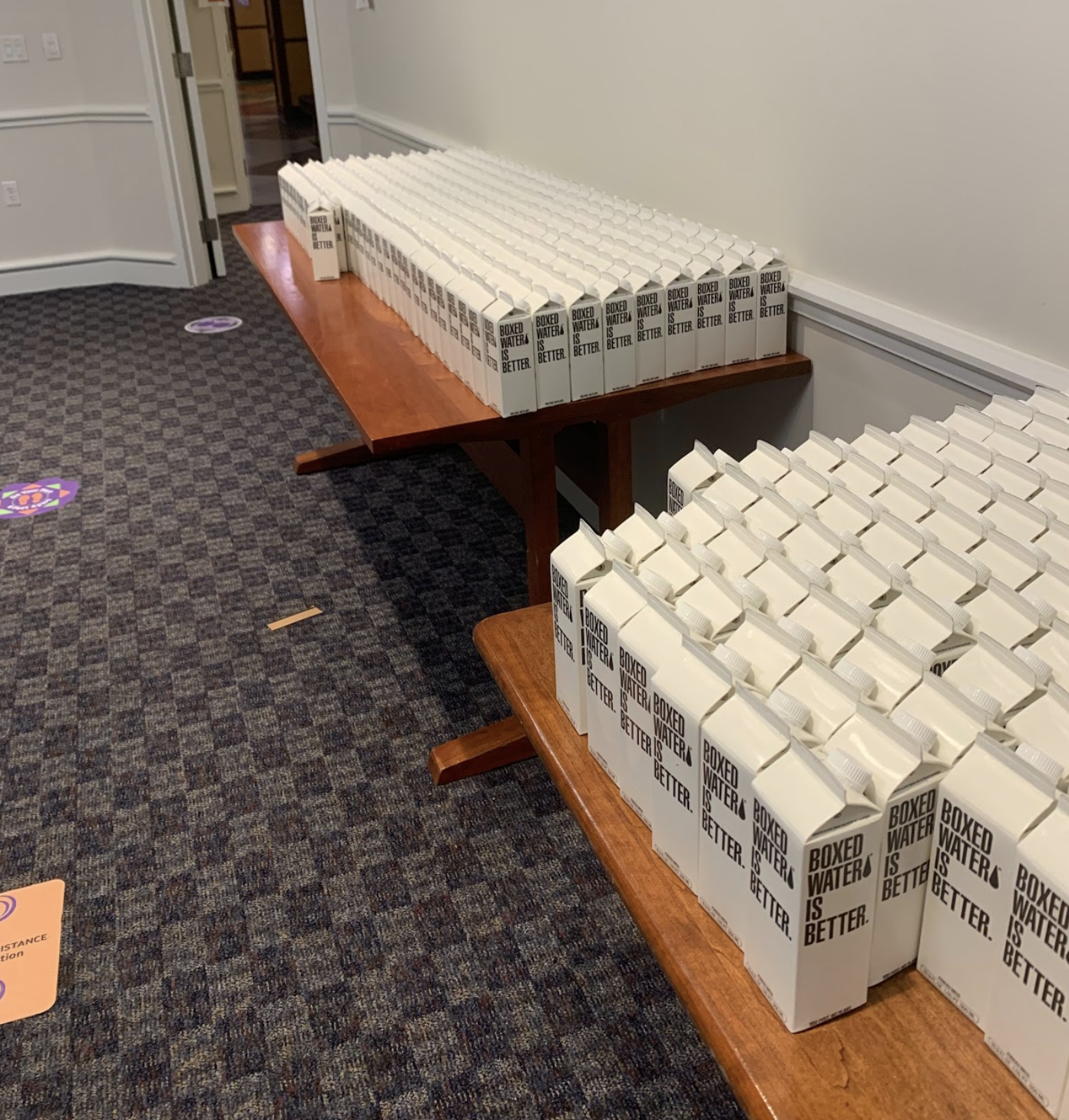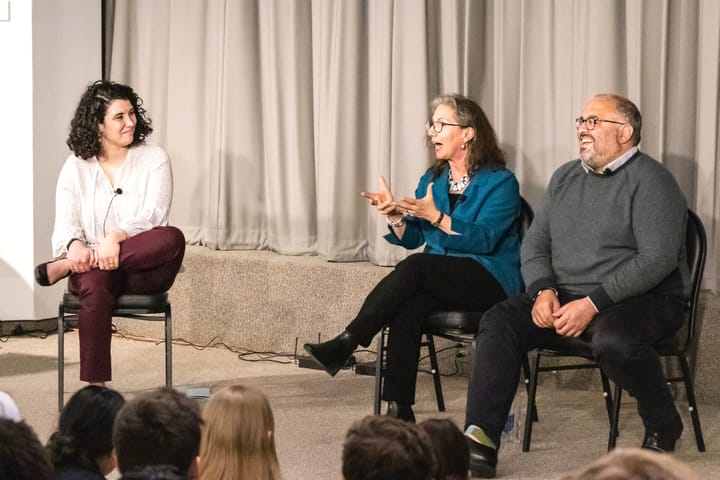With Abundance of Cartons, Campus Questions ‘Is Boxed Water Really Better?’

To keep students hydrated and Covid-free in the fall semester, the college has turned to an out-of-the-box alternative: Boxed Water. The switch to packaged water was made concurrently with the college’s shift to a grab-and-go dining model last spring. However, the proliferation of Boxed Water has been met with mixed reactions from students and staff due to its taste and disposable nature.
Boxed Water is produced by Boxed Water is Better LLC, a Michigan-based company founded in 2009, and was contracted in an effort to meet student water consumption needs while keeping in line with the college’s dedication to environmental stability efforts. The company markets its product as a “plant-based, recyclable, sustainable“ alternative to plastic bottles. It’s first large-scale clients were Chicago music festival Lollapalooza and the Austin City Music festival. The company quickly expanded its clients to Amherst, Harvard, Hope College and selection locations of the Hyatt and Marriott hotel chains by 2013.
According to Joe Fleuckiger, head of dining services, the use of Boxed Water follows a 2016 Association of Amherst Students (AAS) resolution banning the use of plastic water bottles and the college’s general initiatives to move away from plastic bottled water. “Dining services has opted to use boxed water in lieu of bottled water, consistent with the AAS resolution and the desire of students,” he said.
“When dining services shifted to a grab-and-go model in the spring, we found it necessary to use a packaged water product to mitigate the potential spread of the virus,” added Flueckiger. “[This] has eliminated the use of beverage dispensing stations in Val.” Additionally, all water fountains on campus have been disabled in order to slow the spread of germs between students.
As part of the Association for the Advancement of Sustainability in Higher Education (AASHE), Boxed Water Is Better frequently caters to institutions of higher education. Amherst is currently involved with the AASHE through the Chief of Campus Operations’ office.
“We have focused on colleges/universities for years, knowing that college students are most aware of the plastic pollution problem and empowered to make a change,” said Jamie Yale, an account executive for Boxed Water Is Better. “You find them at a lot of higher ed institutions (Harvard, Princeton and [the University of Wisconsin (UW) system). The change has to be driven by the students.” Before arriving at Amherst, President Biddy Martin was the chancellor of University of Wisconsin-Madison, the flagship school in the UW system.
Beyond their product, Boxed Water Is Better is involved in a number of environmental initiatives, including tree-planting and beach clean-up campaigns. Yale noted that in addition to the carton’s minimal environmental footprint, “boxed water cartons are 92 percent plant-based and 100 percent recyclable.”
Despite Boxed Water’s commitment to environmental sustainability, students shared concerns on the product’s actual effectiveness in reducing waste. “I do appreciate that [Boxed Water] is trying to be environmentally friendly by cutting down on plastic, along with their campaign to plant trees,” said Claire Taylor ’23. “But I’m still not a huge fan from an environmental standpoint … Just as we try to not waste paper by printing things out excessively when we don’t need to, why shouldn’t we be encouraging reusable water bottles?”
Isabelle Kim ’23 had similar thoughts. “When it comes down to it, boxed water is still a paper product that comes from trees,” she said. “It’s definitely way better than plastic single use bottles but still doesn’t really combat the problem of single use products.”
Indeed, the college goes through a very large number of boxed waters every day. According to Shannon Wray and Jonathan Padin, two members of the staff at the Lewis-Sebring food pick-up location, a single pick-up location can go through over 20 cases of water in a day.
As each case of water contains 24 cartons, a sole Lewis-Sebring location goes through approximately 480 boxed water cartons per day. This means that the four total food pickup locations use roughly 1,920 cartons of boxed water every day, and 13,440 containers of boxed water each week.

It’s an increase that has led to a noticeable surge in trash. “[Custodians] are noticing more trash, recycling and composting in the outdoor receptacles around campus due to so much of student dining being outside this fall,” said Custodial Supervisor Heidi Kellog. Kellog noted that this increase has been observed “to a lesser extent in the trash containers” than in the recycling receptacles, meaning that while the general trend of disposing of boxed waters leans towards recycling them, not all used containers are recycled.
In general, however, the custodial team approves of the college’s use of Boxed Water. “With the transition to a grab-and-go dining model, Boxed Water provides a safe alternative to beverage dispensing stations in Valentine,” Kellog said. “The custodial team wants to encourage students to keep up their good work by continuing to place their empty Boxed Water containers in recycling.”
Though Boxed Water is a valuable alternative to water fountains for the time being, custodial and dining staff plan to return to more sustainable water access when safe to do so. “We anticipate that the use of Boxed Water will be discontinued when it’s possible to return to the traditional dining model as part of the meal plan,” Fleuckiger said. However, students proved apprehensive about the current inconvenience of depending so much upon Boxed Water.
“I would have loved if Amherst had instead invested in improving the water fountains in each respective dorm so that students have boxed water as a last-resort way of obtaining water,” said Jeanyna Garcia ‘23. “[In] Newport, our water fountain does not work at all and there’s no water bottle filling station available. The only way to obtain water is by getting it through the sink in the kitchen at the basement.”
Aside from the further-reaching implications of Amherst’s use of Boxed Water, the product’s abundance on campus has become a source of amusement among students. @amherstboxedwater, a student-run Instagram account, proclaims boxed water to be “an Amherst College icon” in its “sweet, sweet cardboardy goodness.” The official Boxed Water Is Better account follows @amherstboxedwater and frequently replies to their posts.
The taste of Boxed Water is also a popular student discussion. “Although some people say it tastes more like box than water, I actually really like the taste,” said Taylor.
Boxed water containers have been put to innovative use beyond staying hydrated, as well. The boxes have been used for flower vases, makeshift drinking containers, and even sculptures. “[My friend] had a ton of Boxed Waters in her room, and I took some tape and I taped them together in a little zig-zag pattern,” said Kathleen Harris ’23. “I saw them and I didn’t want to throw them out.”





Comments ()